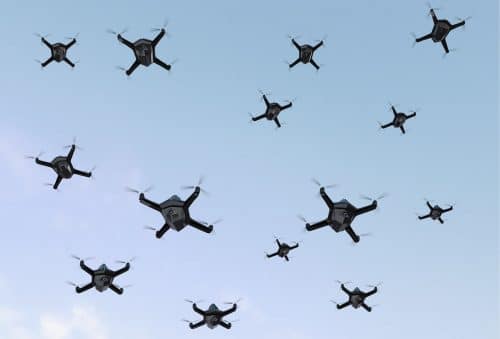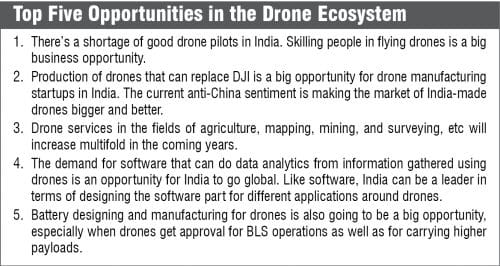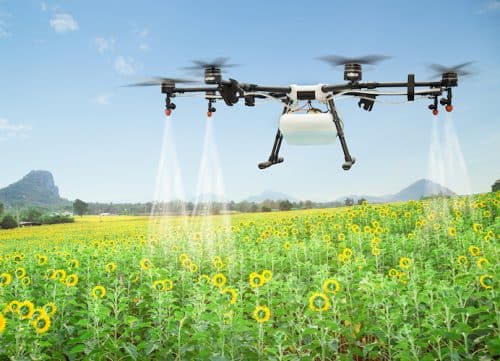It was probably at a high-end wedding that a lot of Indians first got to see a drone in action. Now common across weddings of almost all forms and sizes as a photography tool, drones have become much more than that. Used first by the Indian defense forces in the 1999 Kargil war with Pakistan, drones proved their true worth during the Covid-19 lockdown times as well. From being deployed to record human temperatures to keep an eye on strict locked-down areas, these have been used for a good number of applications.
But what are the business opportunities that the world of drones represents? Is there enough return on investment (ROI) for the people and businesses involved in drone businesses—be it manufacturing or services? We found out!

Current state of adoption of drones in India
“The usage of drones is in its early stages of development in India. However, we are at a much better stage today compared to five years ago. We are now close to about 80,000 to 100,000 drone flights a day. The number was limited to a maximum of around 1,000 five years ago,” says Mughilan T. Ramasamy, co-founder, Skylark Drones.
He adds, “The current state of adoption of drones in India is about one per cent of the actual capacity that the country can achieve. I think India has a potential of at least 10 million drone flights every day!”
Rightly so, a Drone Industry Insights report points out towards India as one of the fastest growing drone markets in the world. The report highlights that the global drone market will grow from $14 billion in 2018 to over $43 billion in 2024. Approximately $3 billion has been invested in drone companies worldwide and 2018 was a record year with $702 million in disclosed global investments.

A report by Federation of India Chambers of Commerce and Industry (FICCI) notes that around 38 companies (2001 onwards) have applied for industrial licenses to manufacture UAVs (another name for drones) in India, and more than 50 start-ups have started providing services in the drone industry. If estimates by NITI Aayog are to be believed, the Indian market for UAV will be $50 billion over the next 15 years.
Photography, as Ramasamy noted, is one of the top-most application areas in India where the maximum number of drones are being deployed. Not just weddings, drone photography has found its place in high-budget Bollywood movies and vlogging. The surveying industry, as per him, is still a dark horse when it comes to the usage of drones in India. He is of the view that as more and more data start coming out of drone usage, more applications will be discovered where these can be used. According to a report by Research and Market, India’s commercial drone market is projected to grow at a CAGR of 12.4 per cent during 2020-2026.
The prime reason behind the increased adoption of drones is the availability of cheaper components that are used in manufacturing these. Tanuj Bhojwani from ispirt explains that components used in drones have become so cheap that almost anyone can create an amateur flying device today. Backing Ramasamy, Bhojwani thinks that India does have a potential of reaching up to ten million drone flights a day.

“The problem is not when a drone goes from point A to point B, but the problem is when ten million drones travel from point A to point B. They can crisscross each other and cause accidents. This is where the Digital Sky comes in. Digital Sky is designed to increase safe adoption and acceleration of drones in India,” says Bhojwani. Digital Sky policy is designed to encourage safe flying of drones in India. Bhojwani explains that even a small accident caused by drones can create wrong impression about the whole industry among people.
“India is in the process of developing standards for drone flying currently. A brilliant set of businesspeople, from countries like Abu Dhabi, Canada, and America, were able to convince authorities in their respective countries to allow them to use the column of aerospace which had become vacant. A few of these were also able to conduct successful unmanned air taxi runs,” informs A.T. Kishore, CEO, Vidya Sangha Technologies.
He adds that something of similar nature has been taking shape in India since last few years. The government of India, as per Kishore, has been working on a scheme called Garuda. Encompassing the use of drones during Covid-19 and locust attacks, Kishore notes that Amber Duber, joint secretary, Ministry of Aviation, has been instrumental in getting that policy implemented on the ground.
Kishore also mentions the need of UAV pilots if India were to achieve the ten million drone-sortie mark. The Aerospace Sector Skills Council of India has also recently launched a drone pilot training programme to facilitate and accelerate the number of drone pilots in the country.

Covid-19: The game changer for drones
One thing that makes drones different from many other technologies existing out there is the fact that these have to be physically carried to the site of operation. Probably, due to the limitations put on these due to low powered battery cells, their flight time generally limits the usage to a couple of hours. Accordingly, drone operations in India were hit majorly during the lockdown period as no movement of people or machinery was allowed for a couple of months.
“The early stages of Covid-19 crisis were exceedingly difficult for all the businesses. In the drone business, it is all about going to the site, flying drones, and collecting data. The mobilisation restriction nailed down the drone business pretty badly in the first few months,” explains Vipul Singh, founder and CEO, Aarav Unmanned Systems.
He adds that even the existing contracts could not be executed as there was absolute restriction on movements throughout the country. The struck supply chains also made it difficult for upgrading drones as hardware parts were struck in transit.
“The hangover is still there. However, Covid-19 lockdowns have made people realise the true worth of using drones for different reasons. Drones, in terms of doing remote work, have been able to click on new avenues of growth,” opines Singh.
From reducing manpower in different areas to lessening time taken to do tasks, drones, during the coronavirus lockdowns, were able to showcase their true worth. Singh explains that both government as well as private players have got a taste of what drones are capable of doing. The acceptance of drone technology during the last few months, as per Singh, has shot up. He further notes that while interest in drones is increasing, the amount of business is not increasing in proportion to the same.
Now, while the newspapers were full of breaking stories on how drones were being used to combat coronavirus in different parts of the world, the number of drones being deployed in India for the same was also big. The impact of drones on coronavirus was so big that the United Nations Children’s Fund (UNICEF) published a study explaining how drones can be used for combating coronavirus. The study mentions lab sample pick-up and delivery and transportation of medical supplies, aerial spraying of public areas in order to disinfect potentially contaminated places, and public space monitoring and guidance during lockdown and quarantine through drones as three usages reported by nations and media.
“In the face of the global Covid-19 pandemic, there have been reported attempts to utilise drone technology in different scenarios, albeit mainly sporadically, and not at scale,” mentions the UNICEF study.
It continues, “A number of different public safety and law enforcement agencies or organisations (Sierra Leone, Rwanda, China, United States, Spain, Italy, France, UK, India, and others) across the world have deployed drones to surveil the public spaces by gaining a better situational awareness and enforce quarantine by sending messages over a loudspeaker and tracking non-compliant citizens.”
“There has been a lot of involvement of drones in India during the covid times,” says Anurag Joshi, co-founder, INDrone Aero Systems.
He adds, “The outlook of what drones can do and how beneficial they can be were proved to the point during corona time. Despite the low staff government bodies were working with, they were still rolling out permissions for drone flights in India. Another six months and we will see the opportunities around drones going up to good numbers.”
Where do the opportunities lie?
The scope of opportunities associated around drones not only encompass manufacturing, components, and software, but span across training and data collection as well. Flying drones is not an easy task as it requires precision better than flying a manned aircraft. And, as the size of drone increases, the difficulty in flying it increases too.

“The increased demand for drone usage during corona time has increased the demand for drone pilot training as well. We converted all our offices into franchises and that has doubled our revenues as well. A lot of people are taking up drone training as a part of the increased demand as a result of Covid-19,” informs John Livingstone, founder CEO & product architect, Johnnette Technologies Pvt Ltd. Livingstone is also the brains behind Indian Institute of Drones (IID).
While there is no study or research done to assess the number of drone pilots that will be needed in the country during the next five years or so, the number of flights estimated (more than ten million) by different experts hint that India will need at least a million, or may be two million, drone pilots. On the contrary, the number of drone pilots certified by a school (DGCA approved), stood barely at fifteen in November 2020. It is to be noted here that drone flying was legalised in India about two years ago.
Varun Bhatia, Head – Standards, Electronics Skill Sector Council of India (ESSCI), says ESSCI has added new dimensions to the drone pilot training programme in India. The same includes thermal scanning, which can be used to scan 20 to 30 people at a time and record their body temperatures. Drones, as per him, have evolved much more than just flying toys. ESSCI has added battery training, motor system training, flying and aerodynamics, and sensors in its curriculum around drones. ESSCI had introduced a course on ‘Drone Piloting and Technician’ in July 2020 (when corona lockdowns were being done away with).
The last few years, as per Singh, saw people trying to push boundaries of drones, keeping the service industry in consideration. A lot of work has been done to make drones more intelligent and agile. Such work has been on the dominant side in the last couple of years in India. A lot in terms of data collection and churning has also been the focus during the last few years, as explained by Singh.
“People are now developing more sector-focused applications for drones. The future of drones is all about how drones can improve the profitability in business and increase productivity at the same time, and that is going to come when we extract more information from the data. Everything happening around drones at the moment is business-centric,” adds Singh.
A study by Fortune Business Insights has projected the global drone services market size to reach $67.43 billion by 2026, exhibiting a CAGR of 41.34 per cent during the forecast period (2020 to 2026). This market size was valued at $4,233.9 million in 2018.
The study points out that the utilisation of drones in military applications will boost this market revenue. “The rising demand for commercial drones in agricultural applications such as crop rotation, crop protection aquaponics, and organic farming will accelerate the drone services market growth. Besides, the increasing requirement for data analytics, data acquisition, and real-time inspection will spur demand for drones, which, in turn, will enable speedy growth of the market in the forthcoming years,” reads the study.
“There are new verticals coming up in the drone services industry. These range from higher payload capable drones to long-range delivery of goods using drones to aerial taxis, and so on. I think standardisation is what will take place in the next couple of years,” mentions Singh.
Giving an example of land surveying by drones, Singh notes that while the likes of him were trying to prove to the government that land surveying through drones is possible, the government now has introduced a programme that includes use of drones for doing land survey of villages in India. The number of villages in India is approximately 660,000. Singh compares the ecosystem of drones to the ecosystem of smartphones. He notes that just like the smartphone ecosystem has developed itself into a big business opportunity, the same will happen to the drone’s ecosystem. The opportunities will include manufacturing, hardware, battery, software, sensors, and even apps designed around drones.
Land survey using drones is just the tip of the iceberg as per Joshi. He is of the view that once beyond line of sight (BLS) flights for drones are allowed, the business opportunities will increase at a higher pace than what India is witnessing now. These opportunities, as explained by Joshi, would include disaster management, surveying pipelines, solar farms, logistics, and more. These operations usually include sending drones 50 to 60 kilometres away from the pilot location.
“A lot of industry sectors know that there is a need, but they are still hesitant to adopt drones as the understanding of the technology is not there. However, if we look at the evolution, it has been phenomenal. From using drones as flying camera devices to now engineering these for focused tasks, the industry has evolved very quickly. Even the number of people consuming data collected by drones has become better,” as per Joshi.
He adds, “The amount of selling required to make people understand the benefits of drones is increasing as a lot of learning from the use-cases is taking place.”
The current value of different parts of the drone ecosystem, as per a global study by Price Waterhouse notes that the drone infrastructure is valued at $45.2 billion, drones in transport services is valued at $13 billion, drones in media and entertainment services is valued at $8.8 billion, drones in telecommunication services is valued at $6.3 billion, drones in agriculture services is valued at $32.4 billion, drones in security services is valued at $10.5 billion, drones in insurance services is valued at $6.8 billion, and drones in mining services is valued at $4.3 billion.
This article is based on a panel discussion around drones that took place during the December 2020 edition of India Technology Week. The discussion was moderated by Neel Mehta, director & co-founder, Asteria Aerospace, and Vichar Shroff, co-founder, burncal.a
Swarm of security drones with surveillance camera flying in the sky
Agriculture drone spraying water-mixed fertiliser on the sunflower field








